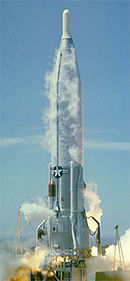Energia was a 1980s super-heavy lift launch vehicle. It was designed by NPO Energia of the Soviet Union as part of the Buran program for a variety of payloads including the Buran spacecraft. Control system main developer enterprise was the Khartron NPO "Electropribor". The Energia used four strap-on boosters each powered by a four-chamber RD-170 engine burning kerosene/LOX, and a central core stage with four single-chamber RD-0120 (11D122) engines fueled by liquid hydrogen/LOX.

Soyuz is a family of expendable Russian and Soviet carrier rockets developed by OKB-1 and manufactured by Progress Rocket Space Centre in Samara, Russia. With over 1,900 flights since its debut in 1966, the Soyuz is the rocket with the most launches in the history of spaceflight.

A booster rocket is either the first stage of a multistage launch vehicle, or else a shorter-burning rocket used in parallel with longer-burning sustainer rockets to augment the space vehicle's takeoff thrust and payload capability. Boosters are traditionally necessary to launch spacecraft into low Earth orbit, and are especially important for a space vehicle to go beyond Earth orbit. The booster is dropped to fall back to Earth once its fuel is expended, a point known as booster engine cut-off (BECO).

National Security Space Launch (NSSL) is a program of the United States Space Force (USSF) intended to assure access to space for United States Department of Defense and other United States government payloads. The program is managed by the Space Force's Space Systems Command (SSC), specifically the Assured Access to Space Directorate (SSC/AA), in partnership with the National Reconnaissance Office.

The Angara rocket family is a family of launch vehicles being developed by the Moscow-based Khrunichev State Research and Production Space Center. The launch vehicles are to put between 3,800 kg (8,400 lb) and 24,500 kg (54,000 lb) into low Earth orbit and are intended, along with Soyuz-2 variants, to replace several existing launch vehicles.
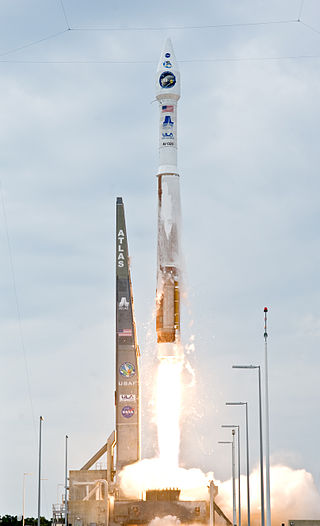
Atlas V is an expendable launch system and the fifth major version in the Atlas launch vehicle family. It was originally designed by Lockheed Martin, now being operated by United Launch Alliance (ULA), a joint venture between Lockheed Martin and Boeing. Atlas V is also a major NASA launch vehicle. It is America's longest-serving active rocket. In August 2021, ULA announced that Atlas V would be retired, and all 29 remaining launches had been sold. As of 10 September 2023, 18 launches remain.

The RD-180 is a rocket engine designed and built in Russia. It features a dual combustion chamber, dual-nozzle design and is fueled by a RP-1/LOX mixture. The RD-180 is derived from the RD-170/RD-171 line of rocket engines, which were used in the Soviet Energia launch vehicle and are still in use in the Ukrainian Zenit launch vehicles.

The RD-170 is the world's most powerful and heaviest liquid-fuel rocket engine. It was designed and produced in the Soviet Union by NPO Energomash for use with the Energia launch vehicle. The engine burns kerosene fuel and LOX oxidizer in four combustion chambers, all supplied by one single-shaft, single-turbine turbopump rated at 170 MW (230,000 hp) in a staged combustion cycle.

Falcon 9 is a partially reusable medium-lift launch vehicle that can carry cargo and crew into Earth orbit, designed, manufactured and launched by American aerospace company SpaceX. It can also be used as an expendable heavy-lift launch vehicle. The first Falcon 9 launch was in June 2010. The first Falcon 9 ISS commercial resupply mission to the ISS launched on 8 October 2012. In 2020 it became the first commercial rocket to ever launch humans to orbit and is currently the only such vehicle capable of doing so. It is the only U.S. rocket currently certified for transporting humans to the International Space Station. In 2022, it became the U.S. rocket with the most launches in history and with the best safety record, having suffered just one flight failure.

The NK-33 and NK-43 are rocket engines designed and built in the late 1960s and early 1970s by the Kuznetsov Design Bureau. The NK designation is derived from the initials of chief designer Nikolay Kuznetsov. The NK-33 was among the most powerful LOX/RP-1 rocket engines when it was built, with a high specific impulse and low structural mass. They were intended for the ill-fated Soviet N1F Moon rocket, which was an upgraded version of the N1. The NK-33A rocket engine is now used on the first stage of the Soyuz-2-1v launch vehicle. When the supply of the NK-33 engines are exhausted, Russia will supply the new RD-193 rocket engine. It used to be the first stage engines of the Antares 100 rocket series, although those engines are rebranded the AJ-26 and the newer Antares 200 and Antares 200+ rocket series uses the RD-181 for the first stage engines, which is a modified RD-191, but shares some properties like a single combustion chamber unlike the two combustion chambers used in the RD-180 of the Atlas V and the four combustion chambers used in the RD-170 of the Energia and Zenit rocket families, and the RD-107, RD-108, RD-117, and RD-118 rocket engines used on all of the variants of the Soyuz rocket.

A modular rocket is a kind of multistage rocket which has components that can interchanged for different missions. Several such rockets use similar concepts such as unified modules to minimize expenses on manufacturing, transportation and for optimization of support infrastructure for flight preparations.

The Common Booster Core (CBC) is an American rocket stage, which is used on the Delta IV rocket as part of a modular rocket system. Delta IV rockets flying in the retired Medium and Medium+ configurations each used a single Common Booster Core as their first stage, while the Heavy configuration uses three; one as the first stage and two as boosters. The Common Booster Core is 40.8 metres (134 ft) long, has a diameter of 5.1 metres (17 ft) and is powered by a single RS-68 engine burning liquid hydrogen and liquid oxygen.

The Atlas III was an American orbital launch vehicle, used in the years between 2000 and 2005. It was developed from the highly successful Atlas II rocket and shared many components. It was the first member of the Atlas family since the Atlas A to feature a "normal" staging method, compared to the previous Atlas family members, which were equipped with two jettisonable outboard engines on the first (booster) stage. The Atlas III was developed further to create the Atlas V, which still flies to this day.

Atlas is a family of US missiles and space launch vehicles that originated with the SM-65 Atlas. The Atlas intercontinental ballistic missile (ICBM) program was initiated in the late 1950s under the Convair Division of General Dynamics. Atlas was a liquid propellant rocket burning RP-1 kerosene fuel with liquid oxygen in three engines configured in an unusual "stage-and-a-half" or "parallel staging" design: two outboard booster engines were jettisoned along with supporting structures during ascent, while the center sustainer engine, propellant tanks and other structural elements remained connected through propellant depletion and engine shutdown.
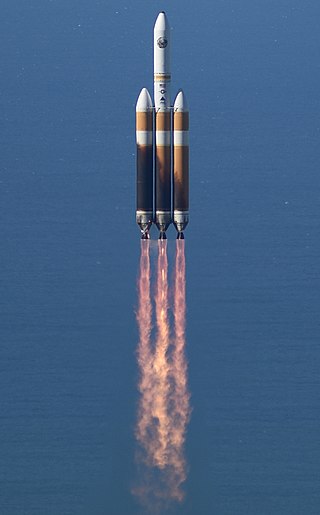
The Delta IV Heavy is an expendable heavy-lift launch vehicle, the largest type of the Delta IV family. It is the world's third highest-capacity launch vehicle in operation, behind NASA's Space Launch System and SpaceX's Falcon Heavy and closely followed by CASC's Long March 5. It is manufactured by United Launch Alliance (ULA) and was first launched in 2004. ULA will retire the Delta IV Heavy in 2024. As of June 2023, one flight remains.
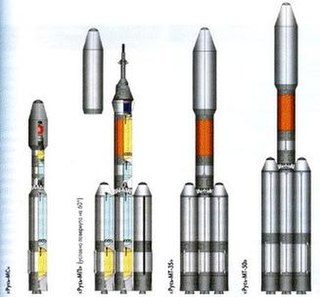
Rus-M was a proposed launcher design which was intended to become Russia's main launch vehicle for crewed spaceflight after 2018, and an integral part of the Orel spacecraft being developed to replace the Soyuz.

Falcon Heavy is a partially reusable super heavy-lift launch vehicle that can carry cargo into Earth orbit, and beyond. It is designed, manufactured and launched by American aerospace company SpaceX.
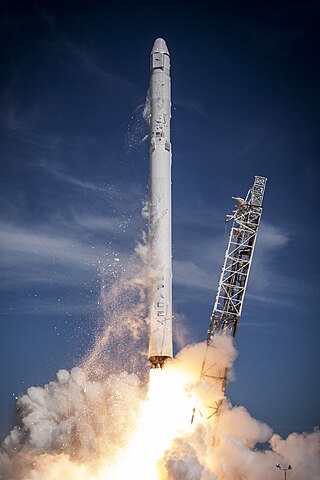
Falcon 9 v1.1 was the second version of SpaceX's Falcon 9 orbital launch vehicle. The rocket was developed in 2011–2013, made its maiden launch in September 2013, and its final flight in January 2016. The Falcon 9 rocket was fully designed, manufactured, and operated by SpaceX. Following the second Commercial Resupply Services (CRS) launch, the initial version Falcon 9 v1.0 was retired from use and replaced by the v1.1 version.

Vulcan Centaur is a two-stage-to-orbit, heavy-lift launch vehicle under development by United Launch Alliance (ULA) since 2014. It is principally designed to meet launch demands for the U.S. government's National Security Space Launch (NSSL) program for use by the United States Space Force and U.S. intelligence agencies for national security satellite launches. It will replace both of ULA's existing launchers in this role, as these launchers are retiring. Vulcan Centaur will also be used for commercial launches, including an order for 38 launches from Kuiper Systems.
The Soyuz-7 or Amur is a partially-reusable, methane–fueled, orbital launch vehicle currently in the design concept stage of development by the Roscosmos State Corporation in Russia. Design began by 2020, with operational flights planned for no earlier than 2028. Amur is intended to substitute for the existing Soyuz-2, at a much lower per launch cost.



















